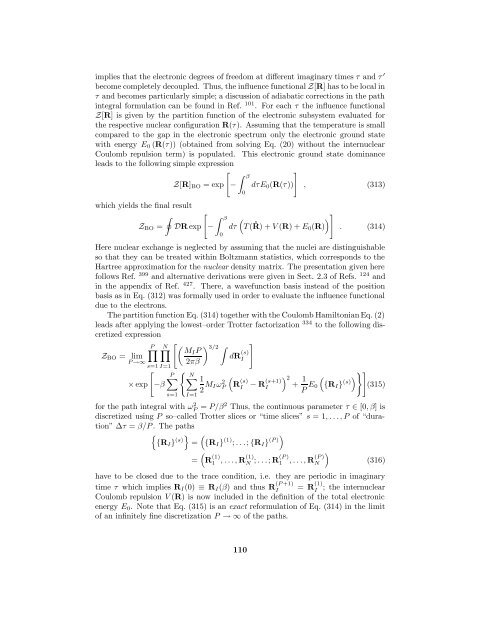Ab initio molecular dynamics: Theory and Implementation
Ab initio molecular dynamics: Theory and Implementation
Ab initio molecular dynamics: Theory and Implementation
- No tags were found...
You also want an ePaper? Increase the reach of your titles
YUMPU automatically turns print PDFs into web optimized ePapers that Google loves.
implies that the electronic degrees of freedom at different imaginary times τ <strong>and</strong> τ ′become completely decoupled. Thus, the influence functional Z[R] has to be local inτ <strong>and</strong> becomes particularly simple; a discussion of adiabatic corrections in the pathintegral formulation can be found in Ref. 101 . For each τ the influence functionalZ[R] is given by the partition function of the electronic subsystem evaluated forthe respective nuclear configuration R(τ). Assuming that the temperature is smallcompared to the gap in the electronic spectrum only the electronic ground statewith energy E 0 (R(τ)) (obtained from solving Eq. (20) without the internuclearCoulomb repulsion term) is populated. This electronic ground state dominanceleads to the following simple expression[]Z[R] BO = expwhich yields the final result∮ [Z BO = DR exp −∫ β0−dτ∫ β0dτE 0 (R(τ)), (313)(T(Ṙ) + V (R) + E 0 (R)) ] . (314)Here nuclear exchange is neglected by assuming that the nuclei are distinguishableso that they can be treated within Boltzmann statistics, which corresponds to theHartree approximation for the nuclear density matrix. The presentation given herefollows Ref. 399 <strong>and</strong> alternative derivations were given in Sect. 2.3 of Refs. 124 <strong>and</strong>in the appendix of Ref. 427 . There, a wavefunction basis instead of the positionbasis as in Eq. (312) was formally used in order to evaluate the influence functionaldue to the electrons.The partition function Eq. (314) together with the Coulomb Hamiltonian Eq. (2)leads after applying the lowest–order Trotter factorization 334 to the following discretizedexpression][P∏ N∏ (MI ) 3/2 ∫PZ BO = limP →∞ 2πβs=1 I=1[ {P∑ ∑ N× exp −βs=1I=11(2 M IωP2dR (s)IR (s)I) 2− R (s+1) 1(I +P E 0 {R I } (s))}] (315)for the path integral with ω 2 P = P/β2 Thus, the continuous parameter τ ∈ [0, β] isdiscretized using P so–called Trotter slices or “time slices” s = 1, . . ., P of “duration”∆τ = β/P. The paths{{R I } (s)} =({R I } (1) ; . . .; {R I } (P))=()R (1)1 , . . .,R(1) N ; . . .;R(P) 1 , . . .,R (P)N(316)have to be closed due to the trace condition, i.e. they are periodic in imaginarytime τ which implies R I (0) ≡ R I (β) <strong>and</strong> thus R (P+1)I= R (1)I; the internuclearCoulomb repulsion V (R) is now included in the def<strong>initio</strong>n of the total electronicenergy E 0 . Note that Eq. (315) is an exact reformulation of Eq. (314) in the limitof an infinitely fine discretization P → ∞ of the paths.110









